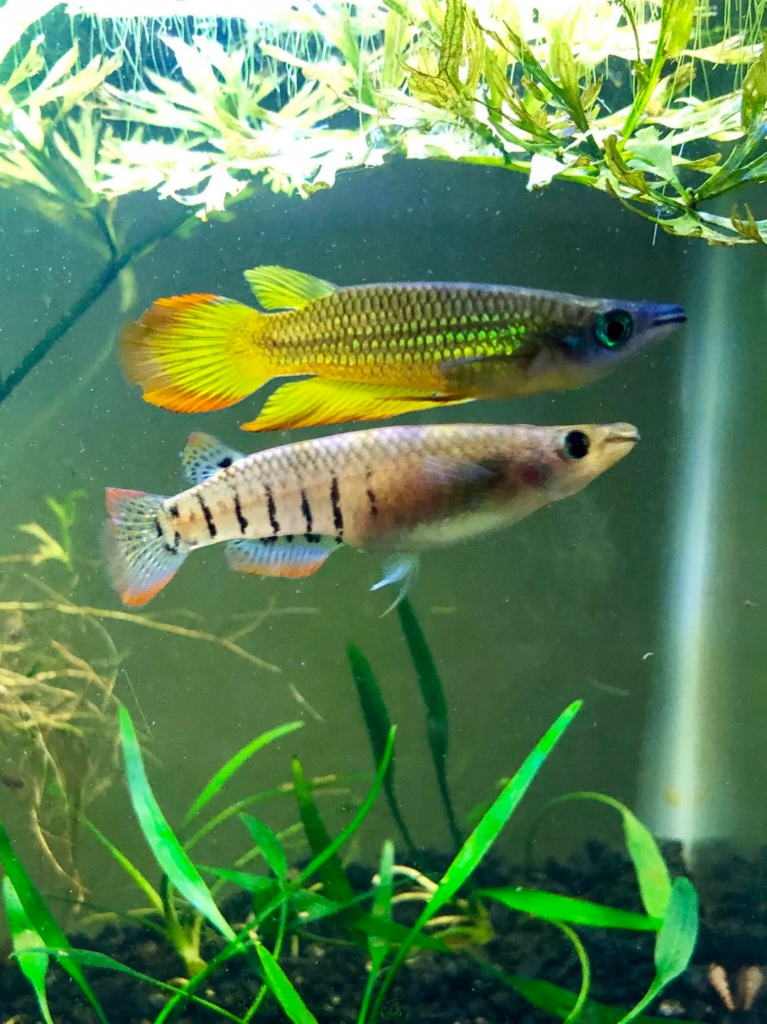The Striped Panchax has long captivated enthusiasts with its striking appearance and their intriguing personalities. In this comprehensive guide, we delve into various aspects of Striped Panchax care, including their characteristics, colors and markings, suitable tankmates, care requirements, diet, gender differences, and breeding behaviors.

Introduction:
Striped Panchax, scientifically known as Aplocheilus lineatus, is a fascinating freshwater fish species that has attracted enthusiast attention for decades.
With their attention-grabbing appearance, intriguing behaviors, and relatively easy-care requirements, Striped Panchax is a great choice for community aquariums. They are commonly also referred to as clown killi and rocket killies.
In this detailed guide, we will cover the different aspects of Striped Panchax care, including their characteristics, origin, colors and markings, suitable tankmates, care requirements, diet and feeding, gender differences, and breeding behaviors.
Characteristics:
Striped Panchax are recognized for their elongated bodies and distinct coloration. They generally possess a streamlined shape with bright vertical stripes running along their sides, creating a banded appearance and their popular name comes from this look. Their fins often have complicated patterns on them that make them look more appealing.
| Scientific Name | Aplocheilus lineatus |
| Common Name | Striped Panchax, Striped Aplocheilus |
| Origin | Southern Asia (India, Sri Lanka, Bangladesh, Myanmar) |
| Life Expectance | 2-3 years in captivity |
| Size | 2-3 inches |
| Color and Marking | bands of iridescent blue, green, and gold hues |
| Tank Size | 10 gallon or larger |
| Temperament | Peaceful |
Origin:
Striped Panchax are native to freshwater territories across South Asia, including regions of India, Bangladesh, Sri Lanka, and Myanmar. They thrive in slow-moving streams, rivers, and marshes with dense vegetation, where they feed on small invertebrates and aquatic insects.
In the wild, striped panchax like clown panchax can be found in both stagnant ponds and flowing streams, adjusting to various environmental conditions.
Size:
Although Striped Panchax are moderately small compared to some other aquarium fish species, they still want adequate space to swim and explore.
Adults of this species often grow to be 2 to 3 inches (5 to 7.5 cm) in length, however, minor variation in size may occur based on factors such as genetics and environmental conditions.
Lifespan:
Branded Panchax (Pseudepiplatys annulatus) can live for about 2 to 3 years on average in captivity. However, there have been reports of some individuals living slightly longer, up to 4 or 5 years, with exceptional care and genetics.
Colors and Markings:

One of the most striking features of striped panchax is their colorful hues and typical markings. Their appearance includes golden-yellow or silver base coloration, adorned with vertical stripes that range from iridescent blue to deep black.
These stripes run the length of their body and provide excellent camouflage in their natural habitat, aiding them to evade predators and ambush prey. Striped panchax may display iridescent scales that shine under proper lighting, further enhancing their beauty.
Tankmates:
When selecting tankmates for Striped Panchax, it is essential to choose tankmates for different species of killifish that are compatible in terms of size, temperament, and water parameters.
Suitable tankmates for Striped Panchax do well with peaceful community fish such as tetras, rasboras, gouramis, and peaceful dwarf cichlids.
Avoid keeping them with hostile or overly territorial species that may harass or intimidate them. Furthermore, Striped Panchax may show some predatory behavior toward smaller fish, so it’s best to refrain from keeping them with extremely tiny species or fry.
Care:
Providing optimal care for Striped Panchax is relatively straightforward, making them suitable for both beginner and experienced aquarists. Here are some key care requirements:
- Water Parameters: Maintain a stable water temperature between 72 to 82°F (22 to 28°C) and a pH level ranging from 6.5 to 7.5. Ensure good water quality by performing regular water changes and monitoring ammonia, nitrite, and nitrate levels.
- Tank Setup: Create a naturalistic environment in the aquarium with plenty of plants, driftwood, and hiding spots. Striped Panchax appreciate densely planted areas where they can seek refuge and explore.
- Tank Size: Provide a tank with a minimum capacity of 20 gallons to accommodate a small group of Striped Panchax comfortably. Ensure ample swimming space and territorial boundaries to prevent aggression among individuals.

Diet and Feeding:
Striped Panchax or Rocket killifish are natural carnivores that thrive on a diet rich in protein and predominantly feed on small invertebrates, insect larvae, and zooplankton in the wild.
In the aquarium, they should be fed a varied diet consisting of high-quality flake or pellet food supplemented with live or frozen foods such as bloodworms, brine shrimp, and daphnia.
Offering a diverse range of foods one can guarantee that Striped Panchax obtains all the essential nutrients they need to stay healthy and vibrant. Give small frequent meals several times a day, making sure they finish everything within a few minutes to prevent overfeeding and water quality issues.
For more on feeding your aquatic pets check out The Ultimate Guide to Fish Food: Pros and Cons & Best Choices!
Gender Differences:
Determining between male and female Striped Panchax can be quite difficult, especially when they are not in breeding condition.
However, during the spawning season, males tend to show brighter colors and longer fins compared to females.
Females may appear slightly rounder in the abdomen, particularly when carrying eggs. Moreover, males may show more intense territorial and breeding behaviors, such as displaying to attract females and defending their territory from competitors.
Breeding:

The best method of breeding for Striped Panchax involves constructing a favorable environment that directly copies their natural habitat conditions to induce spawning.
Inducing Spawning: To induce spawning, provide a well-decorated breeding tank with lots of greenery, like floating plants like Indian fern, where the female can deposit her eggs.
Maintain water parameters within the optimal range and slowly raise the temperature to simulate the onset of the rainy season, generating the breeding instinct. Often regarded as the best breeding method for Striped panchax.
Courtship Behavior: During the breeding season, male Striped Panchax displays radiant colors and engages in elaborate mating displays to attract females.
These displays often involve fin flaring, chasing, and darting movements. The males may also establish territories and defend them against rival males to secure mating opportunities with females.
Spawning Process: Once spawning occurs, remove adult fish to prevent egg predation and optimize survival rates. Striped Panchax are egg-scattering fish, meaning they scatter their eggs among plants or substrates.
See Also: Are Panchax Easy To Breed?
Conclusion:
Striped Panchax are captivating fish species that offer hobbyists a unique combination of beauty, behavior, and ease of care. By understanding their characteristics, origin, care requirements, and breeding behaviors, aquarists can provide optimal conditions for Striped Panchax to thrive and flourish in the aquarium.











1 thought on “Striped Panchax: A Comprehensive Guide for Hobbyists”